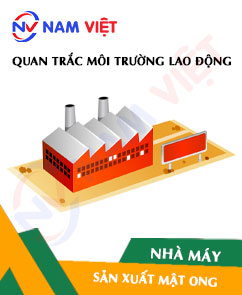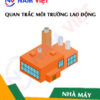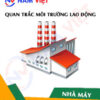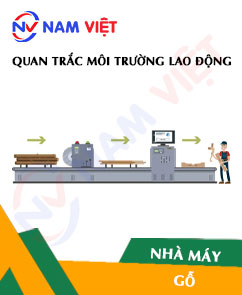Occupational environment monitoring at a honey production factory
99,000 ₫
Note: The above price is calculated for one sample, the price may vary depending on the area of the environment to be monitored and market fluctuations. For more accurate pricing support, please refer to the price list or contact our consulting staff directly.
Monitoring the environment of a honey manufacturing factory is a session of collecting, analyzing, and evaluating workplace factors that may be harmful to workers’ health.
Table of Contents
Toggle1. Overview of Honey Production Factories
a. What is a Honey Production Factory?
A factory producing honey is a facility for producing and processing honey from beehives or bee farms. These factories mainly focus on collecting honey from the hives and processing and packaging it for the market. Honey production factories usually apply strict processes and quality standards to ensure that the final product is pure and safe honey.

b. Production stages in a honey production factory
The honey production process in a factory generally includes the following stages:
- Honey collection: Beekeepers inspect and collect honey from the hives. They use tools such as smoke, bee brushes, and masks to access the hives without harming the bees or the hive. This process requires caution and skill to avoid disturbing the bees’ production process.
- Extracting honey from the hive: Honey is taken from the hive by removing the frames containing honey. These frames, which contain beeswax and honey, are removed from the hive and moved to the next processing step.
- Uncapping honey: During the uncapping process, the beeswax and honey are separated. The beeswax is returned to the hive for reuse, while the honey is collected for further processing.
- Filtering honey: Honey collected from the frames is filtered to remove impurities and debris. This step cleans the honey and ensures product quality.
- Concentration: Filtered honey is concentrated to remove excess water and produce honey with a higher concentration. This step helps the honey become purer and more stable.
- Packaging: After processing, honey is packaged in jars or bottles with labels providing information on origin, ingredients, and expiration date. Packaging is done with measures to protect the product from light, temperature, and humidity to ensure honey quality.

c. Types of machinery used in honey production factories
Honey production factories use various types of machinery and equipment to support production stages. Common machinery includes:
- Honey uncapping machines: Used to separate honey from the beeswax. These machines increase efficiency and save time compared to manual uncapping.
- Honey filtering machines: Used to remove impurities and debris from honey. They often have fine filters to ensure clean honey without contaminants.
- Honey concentration machines: Used to remove excess water from honey. Concentration increases honey density and extends shelf life.
- Honey packaging machines: Used to package honey into jars, bottles, or boxes with product labels. Many machines operate automatically to ensure fast and efficient packaging.
- Quality inspection machines: Used to test honey quality parameters such as purity, moisture content, concentration, and other factors. These machines ensure honey meets quality standards before distribution.

d. Occupational diseases that workers in honey production factories may encounter
Workers in honey production factories may be exposed to several occupational diseases related to their work. Common occupational diseases include:
- Allergies and dermatitis: Workers may react to honey, bee contact, or additives used in honey production. This can cause dermatitis, itching, redness, and other allergic symptoms.
- Respiratory issues: Working in environments with dense honey exposure may affect the respiratory system. Honey particles can irritate or obstruct airways, causing coughing, wheezing, shortness of breath, rhinitis, and sinusitis.
- Eye problems: Exposure to honey or honey smoke can irritate or damage the eyes. Symptoms may include redness, itching, tearing, and eye irritation.
- Digestive issues: Honey may cause digestive problems such as bloating, indigestion, nausea, and diarrhea in sensitive individuals or when exposed to large quantities.
- Poisoning: If honey is contaminated or does not meet hygiene standards, workers may suffer poisoning from bacteria, pesticides, or other contaminants present in the honey.

e. Popular types of honey on the market
There are many popular types of honey on the market, varying in origin and characteristics. Some common types include:
- Wildflower honey: Harvested from nectar of various plants like barley, wildflowers, and other flowers. Wildflower honey has a mild flavor, typically light yellow to light brown in color.
- Legume flower honey: Obtained from nectar of legume plants such as forest beans, green beans, and other legume species. It has a distinct taste and a yellow-brown to dark brown color.
- Sugarcane flower honey: Harvested from sugarcane flowers. It is light yellow and has a strong sweet taste with high sugar content.
- Meadow flower honey: Collected from nectar of meadow plants, dandelions, and other meadow flowers. Its color ranges from light yellow to amber with diverse flavors.
- Forest flower honey: Collected from forest plants such as acacia, pine, coconut, and juniper trees. Forest honey is dark yellow with a rich taste.
- Fruit tree flower honey: Harvested from fruit tree flowers such as orange, grapefruit, mango, plum, coconut, and berries. Fruit tree honey is usually bright yellow with a variety of flavors.
2. Overview of Occupational Environment Monitoring Services
a. What is occupational environment monitoring in honey production factories?
Occupational environment monitoring (or workplace environmental measurement) in honey production factories involves collecting, evaluating, and analyzing measured indicators of occupational environmental factors in the factory. The goal is to promptly implement measures to minimize environmental harm to workers’ health and prevent occupational diseases. Occupational environment monitoring is a mandatory requirement for honey production factories.
This monitoring plays a crucial role in protecting, maintaining, and enhancing worker health, as employees are the primary resource and directly generate profit for the enterprise. Workers regularly exposed to risk factors or occupational hazards exceeding allowed standards may experience health impacts and develop occupational diseases.
REGISTER FOR OCCUPATIONAL ENVIRONMENT MONITORING SERVICE
b. Nam Viet’s occupational environment monitoring program
Nam Viet’s occupational environment monitoring program is researched by monitoring engineers specializing in occupational safety and environmental protection. Aimed at ensuring worker health and safety, the program uses modern measurement methods to monitor air, water, microclimate, physical, and dust factors in the workplace. This program is crucial for maintaining a safe working environment and protecting worker health.
Additionally, Nam Viet’s monitoring program plays an important role in researching and developing new solutions to improve workplace environmental quality. With a dedicated and professional team of monitoring experts, Nam Viet’s exclusive program is a breakthrough in occupational safety management and environmental protection in Vietnam.

c. Standardization in occupational environment measurement procedures
Standardization in Nam Viet’s occupational environment measurement procedures is critical for ensuring accurate and reliable results. To guarantee precision and reliability, the program follows recognized standards and standardized procedures from the Ho Chi Minh City Department of Health. This ensures that collected data can be reliably used for workplace environment evaluation and informed decisions to improve worker health and safety.
These standardized procedures also ensure that measurements are conducted by a highly qualified team of monitoring specialists with years of experience, allowing managers and experts to trust results from An Toan Nam Viet and make precise, valuable decisions in safeguarding worker health and the environment.
By applying standardization in occupational environment measurement procedures, Nam Viet demonstrates its commitment to ensuring a safe working environment, protecting worker health, and contributing to improving occupational safety and environmental management quality in Vietnam.
d. Occupational environment monitoring report for honey production factories
The occupational environment monitoring report is prepared according to Form 04, Appendix III issued with Decree 44/2016/ND-CP and is made in two copies: one is sent to the contracting workplace, and one is kept by the monitoring organization.
The retention period of occupational environment monitoring results is unlimited according to legal regulations.

e. Frequency of occupational environment monitoring according to the law
According to Clause 2 of Article 18 of the Labor Safety and Hygiene Law 84/2015/QH13, employers must organize occupational environment monitoring to evaluate harmful factors at least once a year.
f. Deadline for submitting occupational environment monitoring reports according to the law
The deadline for submitting reports is before December 31 each year. Enterprises must submit occupational environment monitoring results to the local Department of Health at the location of their headquarters and where employees are working.
When there are changes in technology, production processes, or facility upgrades that may introduce new hazardous factors to worker health, enterprises must update occupational hygiene records regarding harmful factors requiring occupational environment monitoring.
g. Penalties for violations of occupational environment monitoring regulations for employers
According to Article 27 of Decree No. 12/2022/ND-CP dated January 17, 2022, regulating administrative penalties in labor, social insurance, and Vietnamese workers working abroad under contracts:
- Clause 2: Fines of VND 2,000,000 – 5,000,000 for employers who fail to publicly inform workers at the monitoring site and the site under hazard evaluation immediately after obtaining monitoring results and hazard assessments.
- Clause 3: Fines of VND 20,000,000 – 40,000,000 for employers who do not conduct occupational environment monitoring to control harmful effects on worker health as required by law.
- Clause 4: Fines of VND 40,000,000 – 60,000,000 for employers who collaborate with monitoring organizations to commit fraud in occupational environment monitoring, but not to the extent of criminal liability.
3. Harmful Environmental Factors for Workers in Honey Production Factories
Workers in honey production factories may be exposed to some harmful environmental factors. Below are some potential environmental factors that may harm workers:
- Environmental pollutants: During honey harvesting and production, honey can be contaminated by pollutants such as chemicals, pesticides, industrial emissions, or environmental pollution from surrounding areas. Exposure to these pollutants can harm workers’ health.
- Additives: In the honey production process, some factories use additives such as preservatives, colorants, sweeteners, etc. These additives may cause irritation or allergic reactions for workers.
- Noise: Machinery and equipment in honey production factories can generate high levels of noise. Continuous and excessive noise can damage hearing and cause hearing problems for workers.
- Temperature and humidity conditions: The working environment in honey production factories may involve high temperatures, high humidity, or sudden temperature changes. Unsuitable temperature and humidity conditions can cause discomfort and difficulty for workers.
- Dust and pollen: Honey production processes may generate dust and pollen in the workspace. Exposure to dust and pollen can irritate workers’ eyes, nose, and respiratory system.
REGISTER FOR OCCUPATIONAL ENVIRONMENT MONITORING SERVICE
4. Measures to Improve the Working Environment in Honey Production Factories
To improve the working environment in honey production factories and ensure workers’ health, the following measures can be applied:
- Ensure safe work procedures: Establish and comply with safe work procedures to reduce the risk of accidents and injuries during honey production. This includes using personal protective equipment, providing occupational safety training, and strict supervision.
- Pollution control: Ensure honey is produced and processed in an uncontaminated environment. Check the origin and quality of raw materials, additives, and production environment to ensure no harmful pollutants are present.
- Noise management: Apply measures to reduce noise in honey production factories, including using soundproof equipment, reducing noise from machinery, and creating a quieter working environment for workers.
- Adjust temperature and humidity: Ensure the working environment has comfortable temperature and humidity for workers to perform efficiently. Use air conditioning and humidity control systems, especially in large-scale production areas.
- Dust and pollen management: Implement dust and pollen control measures during honey production, including dust extraction systems, ventilation fans, and cleaning procedures to reduce exposure to dust and pollen.
- Training and education: Provide training and education on occupational safety, work procedures, and use of personal protective equipment. Additionally, establish health monitoring programs.
- Periodically conduct occupational environment monitoring in factories, collect and analyze harmful factors affecting workers, and adjust to reduce risks to prevent occupational diseases.
5. Benefits of Periodic Monitoring of Honey Production Factories
An Toan Nam Viet provides enterprises with great benefits when using occupational environment monitoring services in accordance with Decree 44/2016/ND-CP on managing and controlling harmful factors in the working environment affecting workers.
- Enterprises can proactively control harmful factors in their workshops or factories.
- Receive advice and recommendations on measures to minimize harmful factors and improve the working environment quality.
- Indirectly protect human resources, the key factor in the development of the enterprise.
- Reduce the impact of occupational diseases on human health, thereby minimizing future treatment costs.
- Improved worker health leads to consistent product quality and production output.
- Comply with occupational safety laws, avoiding legal risks.
- Enhance credibility and professionalism in all aspects, thereby raising the enterprise’s brand value.
Nam Viet’s occupational environment monitoring service is a solution to reduce the impact of occupational diseases and contributes to creating a clean and high-quality working environment.

6. National Occupational Environment Monitoring Center
Occupational Environment Monitoring Center of Nam Viet is a professional unit specializing in monitoring and measuring the quality of the working environment across all provinces in Vietnam. With an experienced team of monitoring specialists, the center uses modern measurement equipment ensuring accuracy and reliability.
In addition to providing monitoring services, the center also assists clients in planning, handling, and following up on occupational environment issues. With the motto “customer-centered,” the center focuses on customer satisfaction, meets all client needs, and is committed to offering the best solutions for enterprises.
REGISTER FOR OCCUPATIONAL ENVIRONMENT MONITORING SERVICE
With investments in technology, equipment, and human resources, Nam Viet’s monitoring center has become one of the most reputable units in the field of occupational environment monitoring in Ho Chi Minh City, with the following goals:
- We always value our brand reputation and the quality of our service products.
- We provide customers with the best and most suitable services possible.
- Alongside our team of experienced Masters and Engineers with expertise, aiming to protect the environment and benefit enterprises.
- By choosing Nam Viet Environmental Monitoring team, your company will receive professional service from experts in the field of monitoring. Additionally, the best cost incentives are provided.
The occupational environment monitoring process at Nam Viet includes the following basic steps:
- Before conducting occupational environment monitoring, our company ensures that machinery and equipment for monitoring are calibrated according to legal regulations.
- Implement the occupational environment monitoring procedures as committed to the Department of Health.
- Honestly report occupational environment monitoring results to the employer.
- If the monitoring results indicate unsafe conditions for workers, Nam Viet will support by providing corrective solutions, and the workplace will implement as follows:
- Implement measures to improve working conditions to minimize the impact of harmful factors and prevent occupational diseases.
- Organize health examinations to detect occupational and related diseases early for workers in unsafe environments.
- Provide in-kind benefits to workers in accordance with labor law regulations.

7. Occupational Environment Monitoring Price Quote
To help enterprises conduct occupational environment monitoring professionally and effectively, Nam Viet provides clients with a price list for occupational environment monitoring services with high quality and reasonable costs.
- Our price list provides detailed information about the costs of the monitoring services we offer, including expenses for travel, measurement, analysis, and reporting results. Clients can fully trust the accuracy and reliability of the monitoring reports we provide.
- We are committed to offering the most competitive and reasonable prices on the market and are always ready to provide quick and professional consultation for any questions about monitoring services.
- With Nam Viet’s price list, clients can easily select service packages suitable for their needs. We are committed to delivering the highest customer satisfaction with professional service quality.
No comments yet












Review Occupational environment monitoring at a honey production factory
There are no reviews yet.